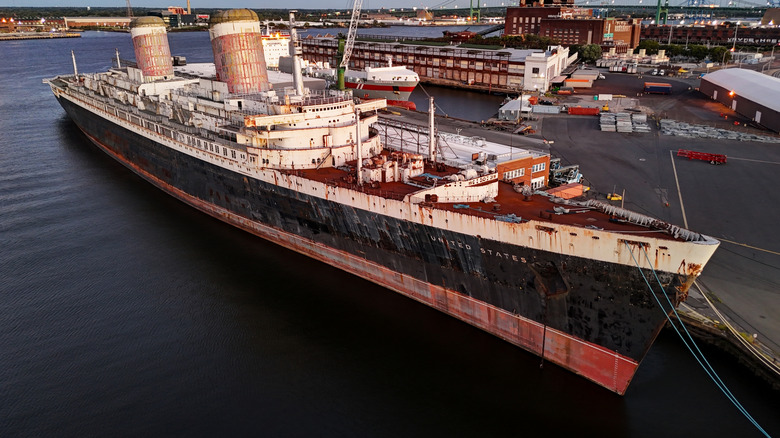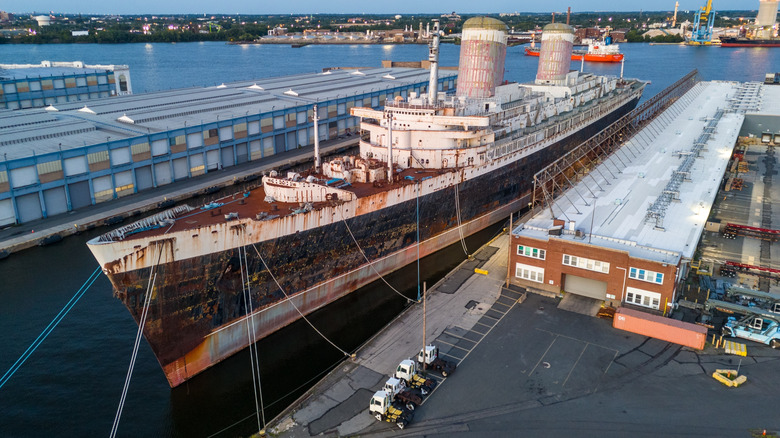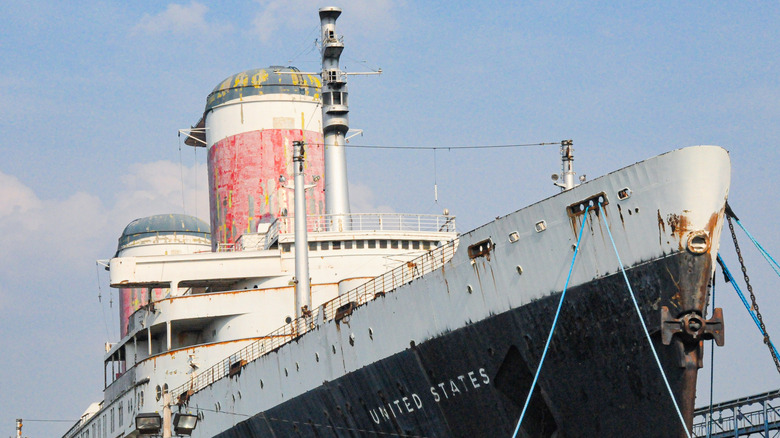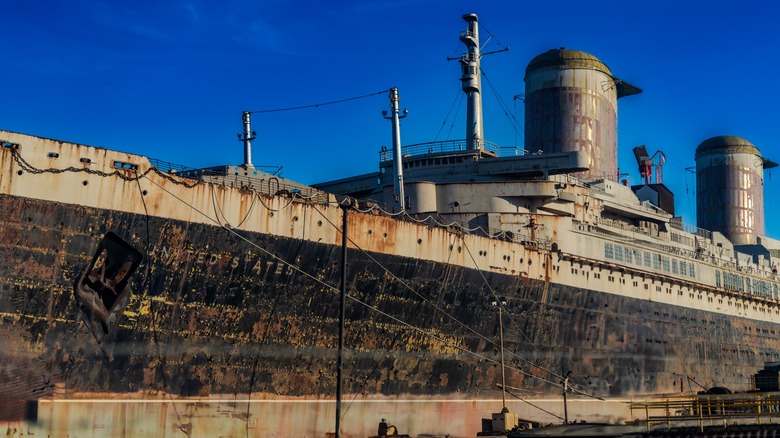What Engines Are In The SS United States?
Once a premier ocean liner sporting one of the world's most powerful engines, the SS United States is set to reach another historic benchmark later this year when it becomes the world's largest man-made reef. Harbored in Philadelphia's Delaware River since the 90s, the now-decaying ship made headlines last week when it set off for Mobile, Alabama, where it will embark on its final voyage: a planned sinking twenty miles off the Gulf Coast.
Built during the post-World War II engineering boom, the SS United States employed a world-class engine that made it the fastest trans-Atlantic oceanliner in history— still holding the speed record some 60 years later. In many ways, this propulsion system was the final hurrah of an era of luxury transoceanic travel made obsolete by the rapid growth of long-distance flights. Retired after just 16 years of operation, the once pinnacle of high-speed luxury travel sat idle in a shipyard for years. Now, one of the shipping industry's greatest technological marvels will delight visitors of a very different ilk. In a $10.1 million deal with the Okaloosa County, Florida, tourism board, the salvageable remains of the SS United States will be stored in a dedicated onshore museum, while the ship itself will sink 180 feet below the surface, becoming a hotbed for wildlife and diving tourists alike.
Unfortunately for these travelers, it will be difficult to distill what made the liner such a technical achievement in its heyday: a state-of-the-art engine that made America's largest passenger ship faster than any competitor that came before or since.
The engine(s) that could
So, how did this behemoth maintain the trans-Atlantic speed record for over 60 years? The answer is in its advanced propulsion plant. The ship had two engine rooms, one at each end of the hull. Between the two of them, the ship sported four Westinghouse steam turbines. The SS United States delivered an incredible 240,000 horsepower and a top speed of 44 mph. Eight oil-fired steam boilers fueled these turbines with over 1,000 psi of pressure, with internal temperatures reaching nearly 1,000 degrees Fahrenheit. The vessel's four propellers (two four-bladed and two five-bladed) were constructed of manganese bronze and weighed 240,000 pounds collectively. The ship's electricity was supplied by six 1,500-kilowatt turbogenerators designed by General Electric, housed in each of the boiler and engine rooms.
This high-powered propulsion system made the SS United States the fastest ship of its kind to date. Embarking on its first voyage in June 1952, the liner broke the transatlantic speed record on both its maiden and return voyages, reaching 38 knots and crossing the Atlantic in 3 days, 10 hours, and 40 minutes— roughly ten hours faster than Queen Mary.
The feat earned the SS United States the honor of being the first American ship in a century to hold the Blue Riband, given to the world's fastest trans-Atlantic liner, an award the historic vessel still holds today.
Large and in charge
The most impressive aspect of the SS United States' engine might be the payload it carried. When it embarked on its maiden voyage in 1952, the ship's size alone made it a technological marvel. Nearly 1,000 feet long and over 100 feet wide, the SS United States dwarfed similar liners like the Titanic and Queen Mary. With over 400 rooms, the vessel could house a then-astounding 3,000 passengers and crew members and held over 148,000 cubic feet of cargo. It was even designed with military versatility in mind and can be transformed into a naval carrier capable of transporting 14,000 troops across 10,000 miles — a conversion accomplished by its luxury ocean liner turned war hero counterpart, the Queen Mary, during WWII. This versatility necessitated that designers add several additional features, including waterproof doors. It also meant that the liner needed to be able to pass through the Panama Canal, limiting the width of its beams.
Despite its size, the SS United States was a relatively lightweight vessel due to its aluminum build. The ship's designer, William Francis Gibbs, used no wood in the construction at all, not even in its lifeboats, to make it essentially fireproof. In fact, the only wooden constructions onboard the United States were its grand pianos. These fire safety protections, along with other safety measures, made many consider the SS United States the safest liner ever built. But its aluminum construction wasn't just a safety measure — it also reduced the ship's weight by almost 10,000 tonnes, enabling it to clock in at a relatively light 53,330 tons. This design gave the SS United States another accolade, making it the largest aluminum construction yet.
Death of an era
The SS United States burst onto a travel industry that was experiencing a major economic windfall. In the wake of WWII, Americans and international travelers alike were traveling in droves, and the owners of the historic vessel – United States Lines were able to take advantage. Several high-profile guests frequented the liner, including four U.S. presidents (including a young Bill Clinton on his way to study at Oxford), Walt Disney, Salvador Dali, and a host of Hollywood celebrities. Even Italy's most famous smile, the Mona Lisa, was transported aboard the vessel for exhibitions in the United States.
Unfortunately for the SS United States, commercial jetliners were introduced just six years after this groundbreaking voyage. And while the record-breaking vessel brought newfound levels of speed and comfort to the transatlantic shipping industry, 44 mph couldn't stand up to the speed and convenience of its new airborne competitors. For reference, by the 1960s, Boeing's 707 had a cruising speed of roughly 600 mph. For most travelers, the differences in travel times were too good to pass up.
By 1968, several of the vessel's counterparts were off the high seas, including the Queen Mary, Queen Elizabeth, and the SS America. By 1969, United States Lines had decided that the luxury ship was too expensive to operate and ended its historic run upon the Atlantic.
Now, the SS United States' engines are embarking on their 401st and final journey. For those nostalgic for a bygone era of travel, the loss is a historical and cultural blow. But perhaps the SS United States can once again represent a major leap forward in its newest venture: sustainable ecotourism.



